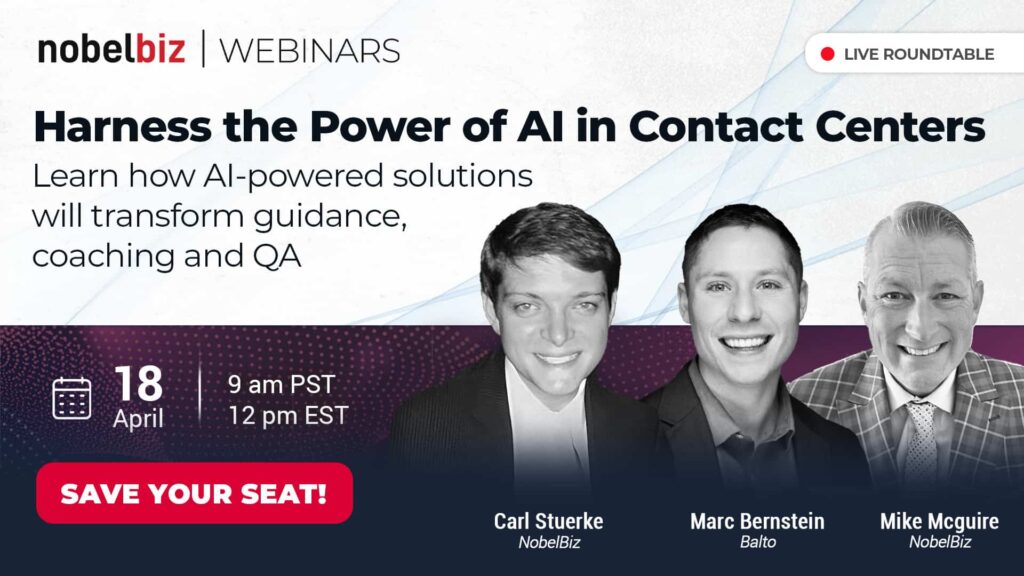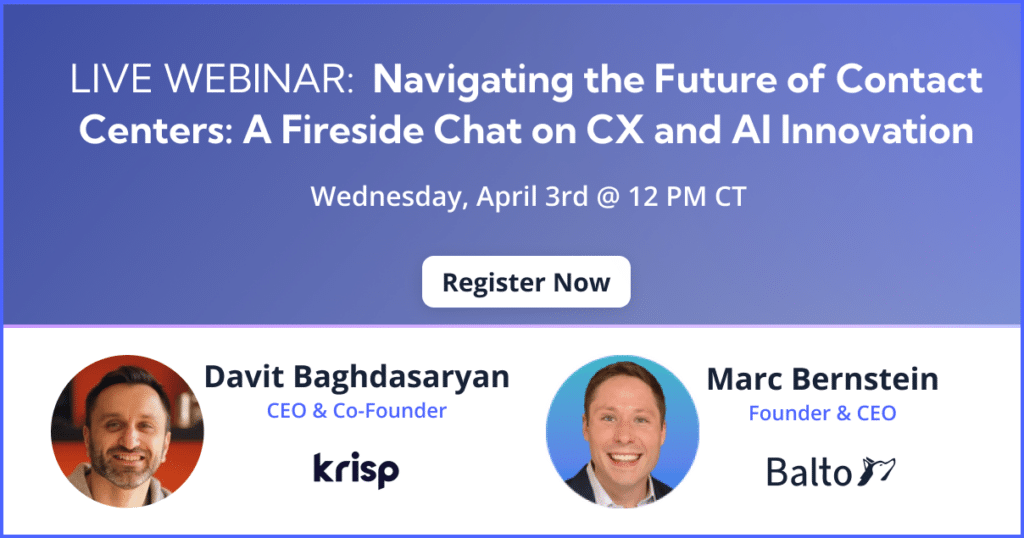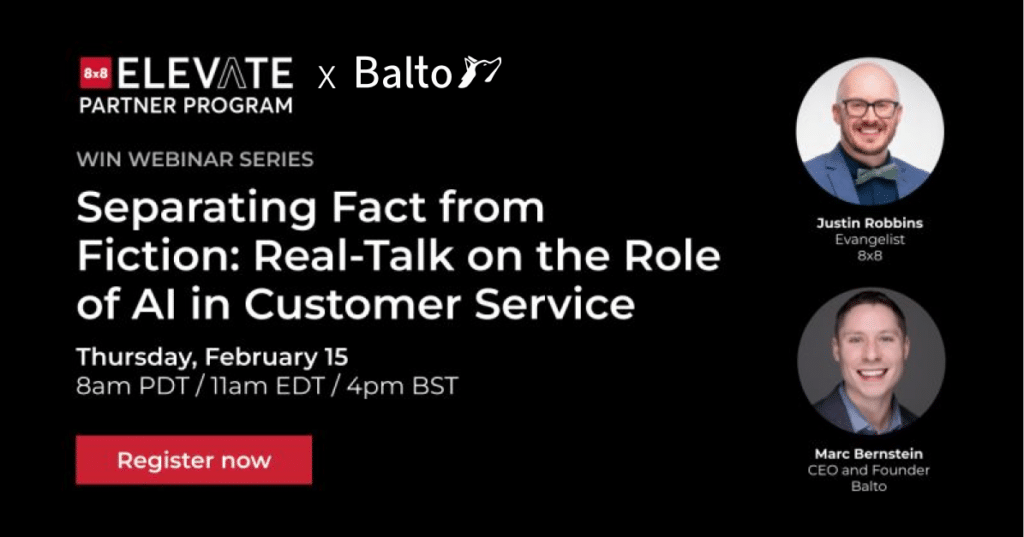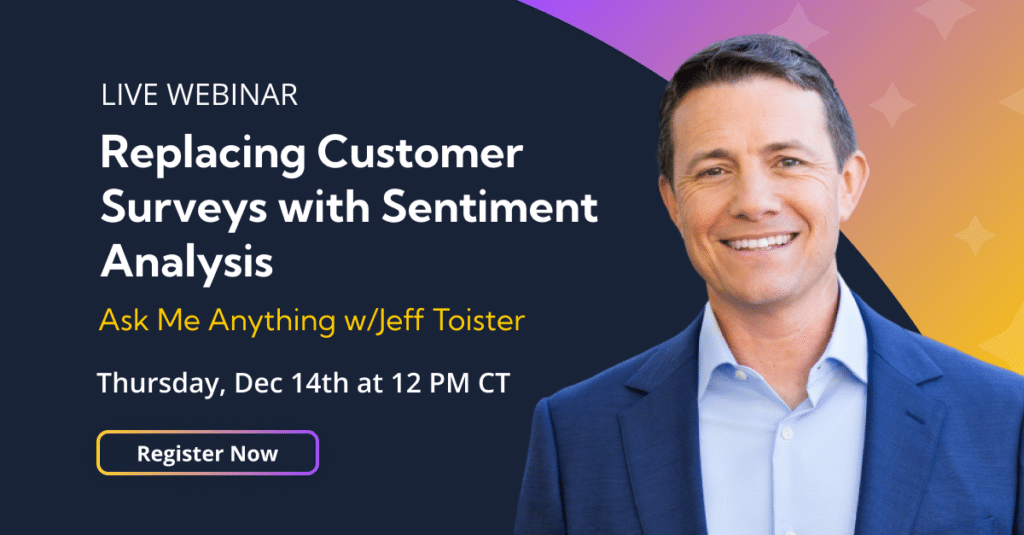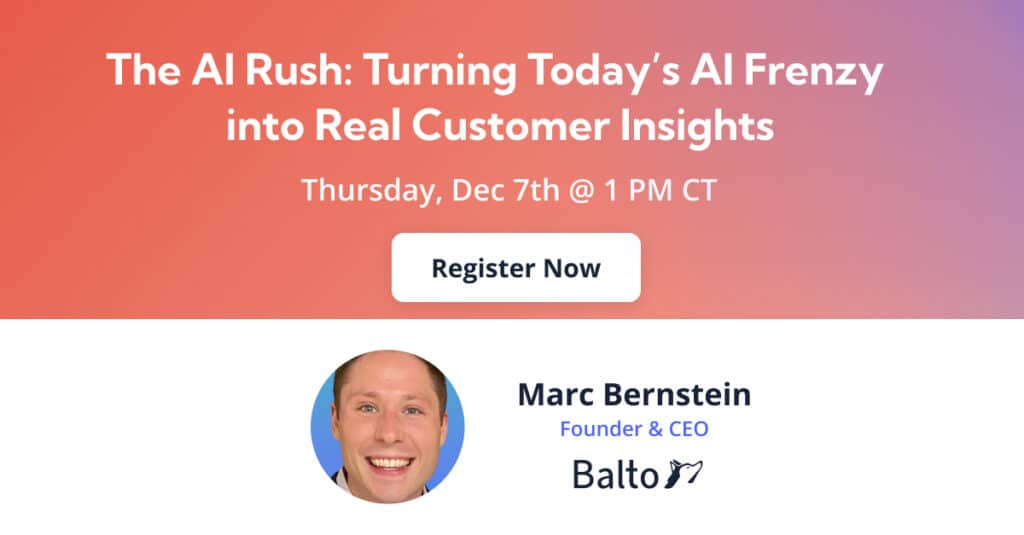How AI and real-time technology can improve calls, coaching, and QA in your contact center
“When we look at sort of our typical approach to coaching, it typically involves listening to maybe one or two calls a week per agent post-call and that’s really the equivalent of trying to score with post-game film. With AI, you really have the ability to make real-time adjustments while the game is still happening and still impact performance on the field.” – Lonnie Johnston, Senior VP of Customer Success at Balto
Enabling excellent conversations in your contact center is more critical now than ever. However, traditional methods for managing agents are overwhelmingly ineffective, time-consuming, and inconsistent. In this webinar, Lonnie Johnston shares how several Balto customers use AI and real-time technology to improve customer experience, boost sales, and achieve nearly flawless compliance scores.
Lauren Tychsen:
Welcome everybody to today’s webinar. We are so happy that you joined us today. The topic is “Boost Agent Performance by Scaling Excellent Conversations” using AI to improve calls, coaching, and QA in your contact center. My name is Lauren Tychsen and I am a member of the Marketing Team here at Balto, and I will be the host and moderator for today’s webinar. And we are very fortunate to have Balto Senior Vice President of Customer Success, Lonnie Johnston, joining us for today’s webinar topic. Before we get started I will go over just a few very quick housekeeping details. Here you can see the agenda for today’s presentation and everything that Lonnie will be speaking about. Today’s session will be about approximately 30 minutes with time for a Q&A at the very end. But if any questions pop up during the presentation and you wanna ask those burning questions immediately feel free to use the QA button on your screen.
Lauren Tychsen:
Also, everybody who registered for today’s webinar will receive a follow-up email with links to access the video recording and the presentation slides from today’s webinar. So if you feel like you missed anything you can always check those recordings and documents after the fact. Without further ado, I would like to introduce our speaker for today, Lonnie Johnston, a Senior Vice President of Customer Success. Lonnie and his team work daily to provide the utmost customer delight and turn Balto customers into passionate company advocates. Lonnie has more than 20 years of experience in the call center and telecommunication space, including past experience in a wide variety of roles at NICE systems and Sprint before coming to Balto. When he is not busy delighting customers, you can find him biking, mountain climbing, and being active all while trying to stay out of the way of his two teenage daughters. But I have a feeling your two teenage daughters probably think you’re a pretty darn cool dad because you go biking and mountain climbing. So I would say that they all love to hang out with you.
Lonnie Johnston:
Yeah.
Lauren Tychsen:
But without further ado, I will pass on over to you Lonnie to go ahead and get things started.
Lonnie Johnston:
Thank you, Lauren. As Lauren mentioned, we’re gonna start with some recent developments in the contact center and it’s hard to really frame anything in terms of recent developments, without acknowledging where we are in terms of pandemic and so forth. And that just has an impact on all of our lives. So in terms of contact centers, to take you back to March of 2020, we were mostly in the office at that time. We typically had in a lot of cases, a lot of old phone equipment, and old infrastructure, and we were trying to make cases for how we all wanted to go digital, and then seemingly overnight work from the home jumped from 10% to 80%. We saw this big investment into infrastructure in order to enable this shift to work from home.
Lonnie Johnston:
There were some coaching challenges that came along with that, and there was some consumer patience, as they knew that we were working through that shift. As we talk about where we’re going next, we thought it would be fun to do a poll and see where you’re all going next. You’ll see it on your screen here. But the question is “Where do you see your team post-pandemic?” As we start to wind things down, we remove masks out of public transit, hopefully, we are entering a new phase here. And so where do you see this going? Is it fully remote? And you’re just gonna stay that way – which we call pants. What pants? I may or may not be wearing slippers right now, myself. Is it a hundred percent in the office? Is everybody coming back in, which is sort of our final wear pants category, or is it more of a hybrid which we definitely I think see options there, something in the middle? A compromise, if you will.
Lonnie Johnston:
We’re gonna leave this poll for just a little bit, but please weigh in. I see we’ve got our results. It looks like we’ve got 61% hybrid. I think this is right in line with what we hear from our customers, that we’ve got some people going back and returning into the office while others are staying completely a hundred percent at home, but the majority seemed to be doing this hybrid piece. We’ve got that tag and you can see in a recent conversation, I had last week with a customer, they acknowledged kind of the same thing. That the hybrid model seems to be where we’re going. They don’t think that we will ever be fully staffed and that this is the new normal if you will. So in these hybrid call centers, because we’ve made this investment, we’re seeing better tools and systems we’ve gotten now comfortable with the fact that we are doing more remote work.
Lonnie Johnston:
We’re starting to figure out some coaching stuff around that, but now that we’re returning back to normal, we’re seeing this heightened customer expectation again, and “I’ll put up with some things during COVID”, seems to be going by the wayside. Some other just ideas and stuff of where we’re headed. You’ll see in the chat we’re gonna share our CEO does a podcast called “Reimagining the Contact Center”, and he has different guests that are on from the industry and they share, what do they think that the contact center of 2030 will look like? The link is actually to Marc’s blog and you can go out and actually see what people are saying out there. It’s a great resource to just kind of think of through some thought leadership and where things are. I think it’s like 30 different industry leaders that are out there and see what they say. You won’t wanna do that during the webinar right now, because you’ll get so intrigued that you won’t wanna listen to me, but click on that link and save it for later. You’ll see there’s a lot of discussions around that the voice channel is here to stay, but at the same time, like this trend towards more and more self-service, we expect to continue. I know what some of our customers share is that they’re seeing the resulting impact is they’re leaving the longer harder calls, but the more strategic contacts still within the voice channel. I would encourage you to check that out. The blog is a really cool resource if you’ve never been out there and don’t already follow Marc today.
Lonnie Johnston:
I was gonna shift into now how we see AI getting applied in the contact center and here at Balto, we believe that there is another shift to where things are headed and that is using artificial intelligence in the contact center. We’re gonna talk about how we impact conversations with AI, how we use it for coaching, and then really how we’re gonna disrupt the quality assurance with how it’s done today. We’ll cover those and do deep dives into each one of these.
Lonnie Johnston:
We’re gonna start first with conversational AI. And what you’ll see is I follow the same structure with each one of these, and we’ll start here with a then and now of sort of the old approach versus where we are now. Some of this is framed up with what we talked about in terms of the discussion we just had.
Lonnie Johnston:
I start with on the left, what I call the “Boiler Room” approach, I had to check and this actually was a movie. If you’re not aware of it from the year 2000, it’s hard to believe that it is that old. I showed some clips to my kids of this and they were amazed, my teenage daughter of a young Vin Diesel and what he looked like. The concept here, and this is definitely when I got into the contact centers how things were run, was that you’d set new agents by tenured and they would really learn sort of the ropes from their tenured agents. Everything from how to overcome objections, how to position a sale, and how to close a sale. So in this example in Boiler Room, Giovanni Ribisi calls over Vin Diesel and he takes over the call, they put it on speakerphone and you can see his son, his reaction here. Everybody learns from the master how to handle a call.
Lonnie Johnston:
This is very much the way things were done. But as you can see on the right, in the remote virtual self-reliant world, we have lost the capability of seeding these best practices. And so the result is that we’ve got a lot of new problems in the contact center. We’ve got inconsistency between individual rep conversations. So what are the best ways to overcome an objection? We’ve got inconsistency across the team where we try to do scripting, typically it’s with like paper scripts posted in a cubicle or used at home. And that makes it difficult to really respond to rebuttals in the moment. It can sound robotic and lack empathy. If you’re reading off and trying to find your way through a paper script of different pages. And so we find that these old models didn’t really account for this shift to remote work.
Lonnie Johnston:
However, with conversational AI, what we see is the ability to recognize speech patterns. So we can actually look at what the customer is saying, what the agent is saying, and then use that to actually trigger guidance in real time. That can help us overcome objections without the searching for getting to know what to do and without the ability to listen to Vin Diesel be our example. It allows for this continual. We also have this ability to learn within each call because we have recording and reporting in the backend. We learn what actually works and what doesn’t work on a call, and then we’re able to incorporate that in and do continuous improvement. As a result, you’re able to create really an entire team of top performers. Just to give you an idea of what this looks like, as you can see, we’re listening to the audio, and James, our example here says “That’s out of my budget.”
Lonnie Johnston:
We’re able to key on the intent that he is talking about a budget objection. So we’re going to queue up a Dynamic Prompt here, that’s gonna queue the agent to first acknowledge that he understands there could be a budget issue and then that we can find something that works within his budget. You can see the rebuttal is “Aside from price is this a product that you’re willing to move forward with?” You can see that there’s room for several suggestions, but we also then provide the ability of a way to give feedback. They can actually say, is this helpful? Yes or not, and give feedback so that we can learn if this was helpful in him overcoming this. You have an ability to vote.
Lonnie Johnston:
I also think it’s important to point out that this dynamic prompt is not something that they have to click on or maneuver with. It’s all driven by his voice. So the customer raises the objection and it pops up on his screen as they actually read the objection it’s going to change and check off automatically, just like you’d be talking like a virtual assistant or whatever in your house. This is your virtual assistant that’s helping you with your calls on your desktop. It’s really able to provide that needed assistance at the moment.
Lonnie Johnston:
Just to jump to an example of where our customers use this. Accelerated Receivable Solutions is one of our shining examples, they actually rolled out Balto in 2019. They were doing a lot of manual call listening and evaluation. They had this problem that we talk about like inconsistent performance. Their agents were using a lot of unstructured rebuttals so there wasn’t a consistency around how they tried to overcome objections that might come up. And it was really difficult with the way that they had their call flows to retain all of the information. By rolling out this Real-Time Guidance, they were able to improve their compliance. They were actually able to reduce their new agent ramp time by two weeks because they were able to get on the phone easier, and got rid of phone anxiety, but also just because they were able to simplify things so much. The agents were able to know more what they were going to through with Balto, that they were able to shorten that whole window. You can see just within the first 30 days, they were able to take things like the improvement of collection of personal information from only happening 41% of the time, up to 87%. Huge improvement in their compliance pieces and so forth.
Lonnie Johnston:
I think what really was the key to their success. And if you ever get a chance to hear from Randy and have her talk about she’s done this. It’s really fantastic. They worked really closely with their agents on how to get that content from them. Those best agents, the Vin Diesels of the world, helped source all of their content and that generated a lot of buy-in to this being not a tool that’s really being pushed down from the top down and is just forced upon them to more “Hey, all you other agents, when you use Balto, you’re using my stuff and this is the stuff that works.” So it really created this sort of pull versus push in terms of using Balto and driving adoption was a big game-changer for them.
Lonnie Johnston:
Next, we’ll talk a little bit about coaching with artificial intelligence. The example I would give you here is the idea of, if you’re coaching, the idea of doing post-game fill review versus in-game adjustments. When we look at sort of our typical approach to coaching, typically involves listening to maybe one or two calls per week per agent typically post-call and that’s really the equivalent of trying to score with post-game film, and you’re doing it just with a post-game call versus what you’re able to do with AI. We’ll kind of dig into this. You really have the ability to make real-time adjustments while the game is still happening and still impact performance on the field. If you can imagine coaching only with a post-game film review, that’s what we’re doing right now. And it’d be like, you’re not allowed to talk during the game and you never watch a game in real time. Which is not how any coach in any sport is gonna work.
Lonnie Johnston:
What we see then is the problem with traditional coaching methods is that those coaching that we get, even if you’re having like the agent listen to a call with you so forth, is they might understand like –okay, I get it. But it’s really hard to translate that coaching into new behaviors and action on a call. What we see a lot of times is they will leave that coaching session and then they go back to the same old behaviors that are sort of ingrained that they’re used to doing. It’s really hard to change your behavior once it really gets ingrained, especially for a tenured agent.
Lonnie Johnston:
We actually surveyed 515 contact center managers. What we learned were a lot of those same things that they’re using the recordings to coach and re-coach their agents that they actually have to coach on average 4.2 times. So more than four times to get a new skill implemented. If you think about like once a week, this is taking a month to get these changes ingrained to where they start to take effect with an agent. What that means is there is a ton of re-coaching and effort that’s spent coaching a lot of the same topics over and over again, because we are doing this in a post-call world.
Lonnie Johnston:
What we’re able to do with AI, the difference here is we’re able to create customizable real-time alerts, which create immediate corrections in the moment – that is our in-game adjustments. So there’s less time actually listening to recordings and more coaching people in-game. An example we have of the customer did this is they had an agent that they were pretty sure was oversharing medical information as they were trying to do insurance medical sales. If you were to look at how you would capture that in the traditional world again, sort of post-game, it is a needle in a haystack to find that in terms of being able to capture that on either a coaching call or QA. But what they were able to do was to build a customized, real-time alert based on the type of behavior they would see as oversharing. And immediately within 24 hours of creating that alert, they were able to see examples of this behavior, starting to pop up where the agent was starting to share information about their own medical history within their family, with a prospect or customer.
Lonnie Johnston:
That’s obviously not something that you’d want to have to happen. So immediately able to capture that versus something that you would spend lots of wasted time and effort trying to find that behavior to where you can actually validate that it’s occurring and change it. With the Real-Time Coaching, they’re able to actually chat the agent up and let them know right there, “Hey, this is not something we want to be doing right now with a customer. We’re gonna need to shift that off.” The way that this looks when it’s applied is that a trigger can show up like this. Like we show an example of a compliance alert. That’s gonna pop up to a supervisor and you can see that they have the ability to listen in. What they see within the listening is a transcript of what’s going on within that call.
Lonnie Johnston:
They can see what customers saying, what the agent’s saying. You can stop and mute that conversation, or you can bring up a chat window. Like, in the example I gave, it just might be something like, “Hey, we don’t want to share our own personal medical information with the customer.” And now you’ve been able to switch that behavior in the moment, stop it from happening, but you’ve also now shifted that immediately. They start to change and exhibit a new behavior right away. So it’s much more effective and moves the needle much faster than the traditional coaching method that we’ve seen in the past.
Lonnie Johnston:
We have a large insurance seller that has deployed this last year and they’re seeing some phenomenal results. They had all the problems we discussed in terms of a lot of delayed coaching, extremely time-consuming for managers, and an enormous amount of time that supervisors spent prepping just for their coaching in terms of trying to listen to calls and finding those coachable moments that were out there. And what they were able to do is shift into this Real-Time Coaching model and use the alerts where they’re able to really drive that to a different outcome. First, let me point out the huge increase in their compliance scores –10% was a big lift for them. They reduced their handle time by 17%, by being able to implement these shifts around Real-Time Coaching. Then within one month, they saw their alerts improved on sales by 19% and outbound call volume by 16% for low-performing agents.
Lonnie Johnston:
There’s sort of two ways that people use this. One is kind of going back to our sports analogy is this will work basically like the red zone channel if you’ve seen that. If you think about it, each one of your agents is playing their own game, all going at the same time. So if you’re in a typical 1:15 – 1:20 type ratio supervisor to agent there are 15 or 20 games going on at the same time. What the red zone channel does is it takes a whole bunch of games that are all going at the same time, and it just shows you the key moments –the long plays, the scoring plays, the things that you really want to see. That’s what you’re able to do with Real-Time Coaching is you’re able to really focus in on the real red zone channel moments of your contact center. And you can set those to know, I wanna see the scoring plays or I wanna see the compliance opportunities, and focus in on those moments that are really important to you to know that they’re happening with your agents.
Lonnie Johnston:
The other way that we see this applied is that you can really focus in on a single agent for a day. If you got something that you’re really working on or you’re trying to reinforce with an agent, you can just set the alerts where you’re only monitoring all of his games throughout the day and nobody else. That allows you to focus a lot more on different behaviors throughout the day, and then chat with that agent throughout the day and influence that behavior. You can imagine the difference between being able to do that with an agent and shift their behavior, especially for a new agent, as opposed to waiting and getting that one coaching session that they might get throughout a day. And so it’s a big shift in terms of the coaching model and it delivers very different results.
Lonnie Johnston:
The last area we’re gonna dive into is Quality Assurance with AI. This is an area where our sort of snapshot here is the “Shot in the dark” sampling versus not being able to keep up with the model. The way this typically works and applied in the real world is most agents are taking 150 – 300 calls a month. And we’re observing maybe four to eight calls between a supervisor and QA agent across them. This is the equivalent of trying to review a movie. Let’s say it’s a two-hour movie and you are going to watch three, one-minute clips of the movie which would be about 2%. That’s what we do with our QA right now today. Would you be able to figure out if that’s a good movie by watching three, one-minute clips at random, somewhere in the part of the movie, and get an idea of what happens? Obviously, that sets up the problems for the traditional QA methods, which is – sampling just doesn’t work. It might work for the entire call center. Do I have an idea of what’s going on by listening to two and a half percent? But to really get an idea, a solid idea of what’s going with agent performance, it’s pretty light and agents really view it as unfair.
Lonnie Johnston:
With AI, what we’re able to do is monitor effectiveness instantaneously. We do this scoring in real-time, so they can actually see their scores come in throughout the day as they take their calls. We review 100% of calls, not just that 1% – 2%. So it removes all of the spot-checking, and you’re able to actually review 100% of all calls all the time. That really allows us to be sure that we’re correcting mistakes before they become habits. As we discussed earlier on the coaching side, they kind of go hand in hand.
Lonnie Johnston:
An example of what this would look like is you can see your call categories, you can see sort of how we would score the different elements. These get built out and again there is detailed real-time reporting on this for each one of your agents, and you can drill in and do this. It’s also very effective for when you want to do your monitorings, that you can drill in and know that you are listening where there are interesting calls. If you want to link this to your call recording, then you can listen to the calls where you’ve seen that there are misses, where maybe there were objections that didn’t have rebuttals, and follow up and drill into that.
Lonnie Johnston:
Again, a very effective tool. The example we have here is with UGA finance, they had all the problems we talk about of looking at 1% of call volume which is still time-consuming, costly, very manual, and ultimately was ineffective in driving the outcomes that they were looking for. By switching into Real-Time QA, a hundred percent of calls analyzed. They saw an improvement in their agent performance scores, it went up 40% up to 80% compliance and huge savings that they were able to implement by being able to shift into this model.
Lonnie Johnston:
In summary, what we see with Balto is that customers are able to empower their agents to convert and save more opportunities and therefore deliver more sales. They delight more customers. We see big improvements in CSAT, across a lot of customers. Then especially with the QA compliance angle, they are able to deliver a lot of improvements very quickly there across this product suite.
Lonnie Johnston:
I tried to give you an idea of some of the snapshots here of how this works, but I think the best way to really get an idea of what this AI can look like in the contact center is to get a demo of Balto. What you can do is go to balto.ai/getdemo. You can see the link here on your screen and schedule your own demo. There’s also a link in the chat if you just wanna click on it there, and that will allow you to get on and schedule your own demo, and you can really get a sense of what this whole product week looks like from their end. With that, we can move into QA. I know Lauren’s gonna jump back on and help us through that. So, Lauren?
Lauren Tychsen:
Yes. Thank you so much, Lonnie, for all of that fantastic information, insight, and customer results. Really appreciate your time and you taking us and walking us through all of that.
Lonnie Johnston:
Fantastic.
Lauren Tychsen:
Next, we want to hear from you guys. So if you have any questions, go ahead and drop them into the Q&A section. It looks like we do have a few great questions that are coming in. So let’s go ahead and jump into the first question. Lonnie, are you ready?
Lonnie Johnston:
Yes.
Lauren Tychsen:
All right. First question, how can I help my agents embrace and adopt new systems or methods?
Lonnie Johnston:
Yeah. Adoption is always a question with new technology. We talked about Randy’s example of how she really engaged her existing agents. There are a couple of other ways that she does that. She works with her compliance team to be careful of how they incorporate things into the tool as well. But then I think on the continued improvement, they actually make it a contest. So it is a point of pride that top agents get their rebuttals put in there. Definitely, their mindset is if you don’t like the information that is Balto then we should get better content and we should improve it. They want their best agents using Balto so that you were able to see that in the scoring and so forth, but there’s also this point of pride of, “Hey, I made a suggestion, they have kind of a voting process and it was accepted”, and that’s my content that’s out there in Balto. And so there’s a lot of rewards and streams that kind of go into that, that work really well. I think the other key point, I think to make there is like she can make those changes and incorporate that in like five minutes. So she’s always going out and making changes and refreshing the content on a day-to-day basis because it just doesn’t take that long to get those new rebuttals and so forth in there. When agents see that there’s always new content and they’re incentive to do that, they’re always pushing and driving new stuff in. So it works really well.
Lauren Tychsen:
Yeah. It’s kind of like a badge of honor for them to see their own.
Lonnie Johnston:
Yeah, absolutely.
Lauren Tychsen:
That works successfully for them so they can kind of share their best practices and feel like they’re the subject matter experts, which is really good.
Lonnie Johnston:
Everybody wants to be the Vin Diesel of their Boiler Room.
Lauren Tychsen:
I wanna Vin Diesel.
Lonnie Johnston:
I copied his haircut for that exact reason. Yes.
Lauren Tychsen:
Perfect. Well onto the next question here. What is the typical implementation timeframe and will this require API integration with dialer or CRM or both?
Lonnie Johnston:
Yeah. We have integrations that use APIs that are available. Other ones require scripts. The configuration just varies from integration and integration with our softphone. We have about 50 integrations that we work with already today. A lot of this is already built out. It just varies in the method that we use, our preferred obviously is API and we’re getting more and more of those built out and we have a number of those that are already built today.
Lauren Tychsen:
Perfect. Then the next question looks like we’ve got a couple more minutes left. The next question…
Lonnie Johnston:
I saw one asking if Balto is compatible with Genesys or Salesforce. Yes. To both those, you know doing 50 different integrations. We work across a bunch of different ones. So I think that’s kind of a follow-up to what we already heard. All the ones that you would think of as far as RingCentral and NICE and so forth, the big players – we do all those, but we do a lot of small ones as well. So sorry Lauren, I interrupted.
Lauren Tychsen:
Not a problem at all. I think we have one time for one more question. Does this work with tenured agents?
Lonnie Johnston:
It does. It is that point of pride deal as well, but in order to really make the reporting effective around what works and what doesn’t work, you want to go to those best agents to say, all right, if you don’t like what’s in there, help me incorporate and help me make the tool better by incorporating your stuff into it. But then I need you to say it so that we’re able to see that that’s effective and it feeds into the analytics as well so that more people know to use your type of responses. And so if you wanna be there like Vin Diesel, I need you using the tool so we’re able to acknowledge that and see your best performance in there. It’s very effective, I think with tenured agents for that way. And again, it’s hard to influence the behaviors of tenured agents a lot of times. We used to do like chair drops and so forth. You don’t need to do chair drops in this world. In terms of being able to get the sort of new, improved rebuttals that could be out there. Over time we find that tenured agents become open to that as well.
Lauren Tychsen:
Perfect. Great. Well, it looks like we are just about out of time for today’s session but I wanted to thank everybody for joining us and submitting your questions and a huge thank you to you, Lonnie for sharing such valuable information with us today. Do you have any last-minute thoughts before we all sign off?
Lonnie Johnston:
No, I could see some of the questions I know we’re not gonna get to. I would just encourage people to set up a demo, and reach out to us, we’d be happy to walk through and answer all your questions one by one. Definitely reach out to us and we’re happy to get through all those. Sorry, we didn’t get to all the questions today but do reach out. We’re happy to connect with you.
Lauren Tychsen:
Agreed.
Lonnie Johnston:
Thank you, everybody.
Lauren Tychsen:
Thank you so much, guys. Really appreciate it and have a fantastic day!
Resources shared during the broadcast:
- Download Presentation Slides (PDF)
- Blog Post: 30 industry leaders answer “What does the contact center of 2030 look like?”
- Report: We Surveyed 515 Contact Center Managers about Coaching. Conclusion: It’s Not Working.
- Case Study: UGA Finance Nets Tangible Gains with Balto’s Real-Time Quality Assurance
- See Balto in Action – Schedule a Demo

